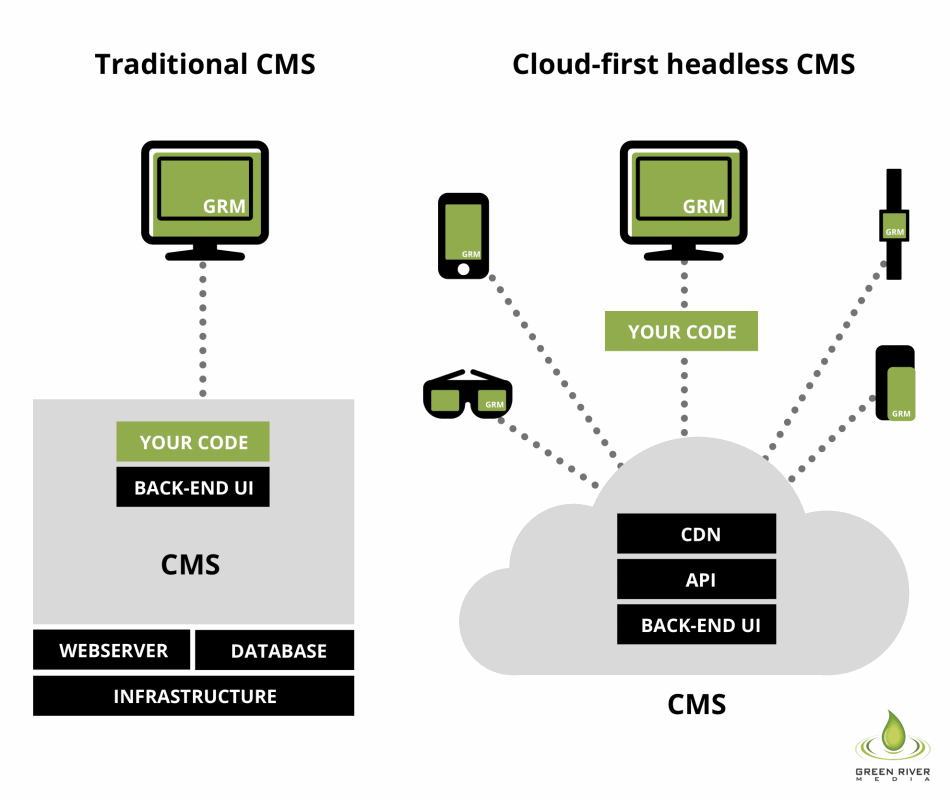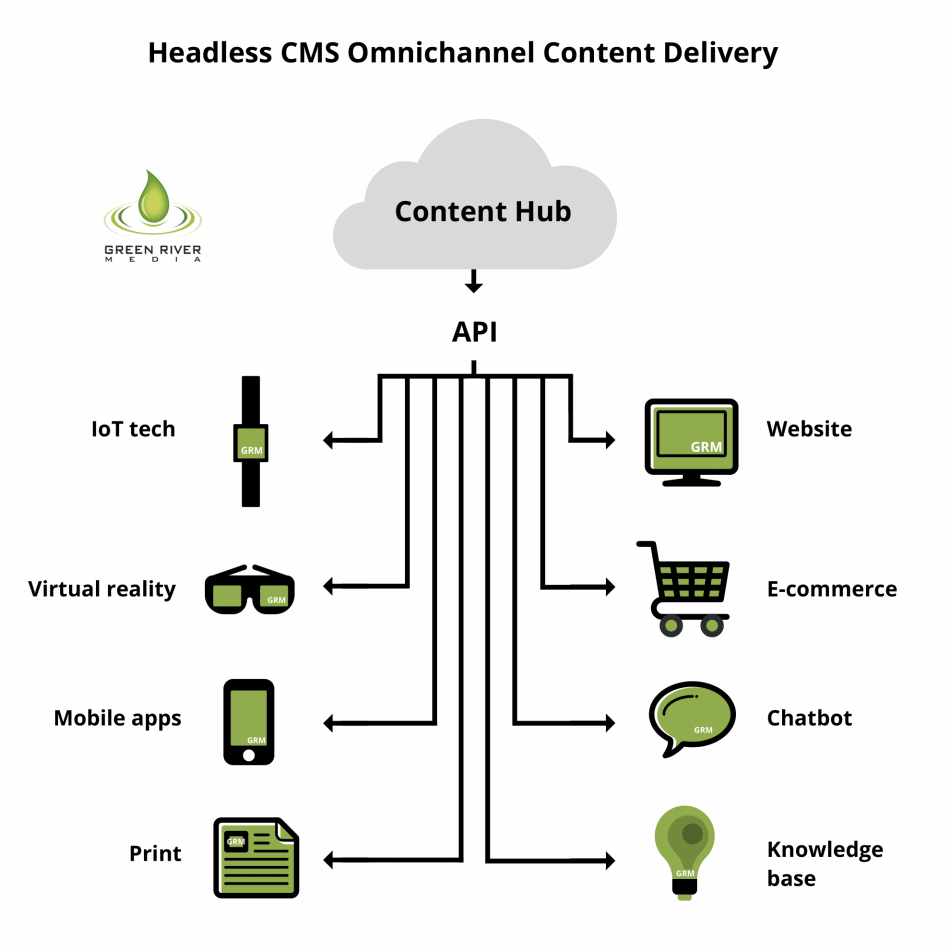What is a Headless CMS & Do You Need One?

In recent years there has been a tremendous shift in the way that customers consume content online. With the average person owning over 3 connected devices and using mobile for over 58% of their browsing, businesses are faced with the tough task of delivering the right content, at the right time, and correctly adapted to each and every device. Traditional Content Management Systems (CMS) were built simply with websites in mind, and as such, they’ve been forced to adapt to this radical change in user behaviour. So, what’s the answer? If you’re a business who prioritise the delivery of multichannel content and want to engage with your customers at every possible touchpoint, you may choose to opt for what’s known as a ‘cloud-first headless CMS’.
Throughout this blog, we’ll discuss the topic of headless CMS so that you can make an informed decision on whether it’s the best solution for your business.
What is a headless CMS?
A Headless CMS is a content management system that completely separates the design and content of a website. Content is created centrally in the CMS and accessed on multiple devices using an API.
Unlike traditional CMS, headless does not control the presentation, so marketers can simply input their content into the CMS and leave developers to control how it renders on multiple devices. Content is created just once which saves time for marketers and allows front-end developers to focus on creating the best experience for each channel.

Why use a headless CMS?
Here are some of the key reasons why you may choose to opt for headless as part of your next CMS website development.
Headless CMS Advantages
Speed of Content Creation
According to eMarketer, 60% of marketers create at least one piece of content each day. Content marketing was once considered ‘King’. It’s now considered the norm and marketers are continually striving to deliver increasing amounts of engaging content to their audiences via multiple channels. A headless CMS architecture can help dramatically in this respect, by enabling marketers to create content only once that can be published across all channels via an API. Not only does it help with creating content in the first instance, but users of a headless CMS will also find it much simpler to edit existing content on an ongoing basis. Simply edit the source content and all channels will be automatically updated, reducing duplication of work. With headless CMS, omnichannel marketing activity at scale is becoming a reality for marketing teams.
Futureproof your CMS
An API-driven CMS will be more flexible to the ever-changing world of technology, ultimately futureproofing your digital assets. Cloud-first headless CMS is the next level for businesses wanting to adopt a content-first digital strategy. It was only in November 2014 when the first Amazon Alexa home assistant hit the shelves, and now ComScore claims that 50% of all searches will be voice searches by 2020. No-one knows what the next method of content delivery will include, but you can be sure that with a headless CMS you’ll be one step ahead of the game.
Provide an improved user experience
According to Invision, every $1 invested in user experience design yields a return of $100–9,900% ROI. There’s no doubt that as technology has advanced, users have become accustomed to a better user experience online. Customers prioritise brands based on their interactions online and those who fail to adapt will face falling behind their competitors. Creating a slick user experience has historically had its challenges by needing to design one interface that renders on multiple devices. Headless CMS, on the other hand, will allow designers and UX professionals to create a world-class user experience for any piece of content on any device, whether that be a web page, APP, virtual reality or a digital billboard.
What are the downsides to headless CMS?
As with all new technologies, it’s important to weigh up the pros and cons before making your decision to migrate. Let’s take a look at some of the downsides to using a headless CMS.
Lack of design visibility
Despite the immense multichannel content population that headless brings, marketers may seem a little lost when inputting content into a headless CMS. Inputting content can be as simple as using a basic WYSIWYG editor, with little or next to no previews of what the finished design will look like. In many ways, this takes the user experience out of the marketers’ hands and more so into the hands of front-end developers. In order to maintain that exceptional speed of content population that headless CMS is all about, marketers will have to work more closely with their front-end developers to get at least a basic idea of how the finished article will look for end users.
New technical requirements
Technical proficiencies may be a concern for businesses that don’t have the existing in-house expertise or sufficient funds to outsource multiple front-end development requirements. For smaller businesses, it may make sense to stick with a traditional CMS or opt for a coupled CMS in this case rather than invest heavily in headless without the ongoing resources to make full use of its features. Larger businesses adopting headless may find that their existing development teams don’t have the required skills to work with multiple platforms such as websites, apps, virtual reality and so on. Those looking to invest in a headless platform will want to perform a full resource/capability audit prior to choosing their CMS.
When should you use a headless CMS?
Use a headless CMS if…
- Your marketing team want to focus on an omnichannel content marketing strategy
- You want to provide the best user experience for your customers across all devices
- You want to consolidate content from multiple departments to remove content duplication
Use a traditional CMS if…
- You don’t have a focus on creating digital experiences on other channels such as chatbots, apps, and virtual reality
- You don’t have sufficient in-house experience or financial resource for regular front end development
- You want to host the CMS on your own servers
Typical scenarios for using headless CMS
Struggling to visualise the use cases and scenarios in which you might benefit from a headless CMS? Let’s take a look at some of the key examples.
.png)
Content Hub
You’re a large, multinational business with multiple websites and software platforms all housing content managed by different departments.
Content duplication is widespread in large organisations as departments tend to work in silos rather than in tandem when it comes to their content generation. Housing multiple pieces of content on the same subject can lead to huge inconsistencies and a lack of understanding of accurate content. Using headless architecture would be an excellent option in this instance, as all sources of content can be pulled into one central hub for collaboration. Content can then be exported from the content hub and delivered to channels such as your website or app using an API.

Omni-channel Publishing
You’re a retail brand that publishes the same content to varying users across multiple platforms such as websites, apps, e-commerce, chatbots, and print.
Your marketing team may benefit from a headless CMS to increase their content output levels. Team resources will be better utilised as content can be pulled from one single resource rather than duplication across devices. Front end developers will be able to focus on creating the best user experience for each individual channel/device.
Summary
There isn’t a single CMS solution that is 100% right for every business, hence the plethora of options available. It can be a minefield for any marketer looking at their next platform, that’s why it’s so important to weigh up the pros and cons and take advice from a digital agency that has vast experience working with multiple CMS solutions. Headless CMS is certainly not just a buzzword in the web development world, it’s a major advancement in development that brings great benefits if you have a focus on providing world-class omnichannel experiences for your customers. If content creation is a key part of your strategy, or if you’re looking for something that is futureproofed with the flexibility to grow along with your business, you may choose to opt for a headless CMS as your next solution.
To find out more about the CMS solutions available for your business, please call our web development experts on +44 (0)203 397 4155 or email [email protected].
